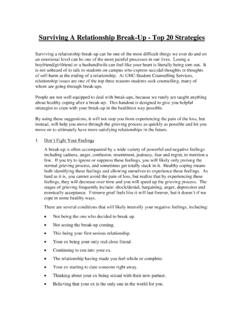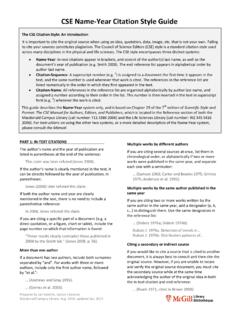Transcription of RE9ISED 2022 - McGill University
1 2 How to Write a CVCopyright 2019 McGill Career Planning ServiceWe see a lot of CVs at CaPS. Every year we read and review literally thousands of them, for job, intern-ship, grad school and funding applications. They are from students of all levels representing each of the faculties and schools at McGill . While there is definitely room for individual variation, some things clearly work better than others. Use the information, tips and samples in this guide to start writing and organizing your CV, then come to a CaPS CV drop-in or make an appointment for an individual consultation to ensure that your applications are as professional and customized as they can be!
2 GETTING STARTEDWhat s the point of a CV?A CV provides a potential employer with a quick summary/overview of your experience, background and skills to help them decide if you are a good candidate to invite for an interview. CVs are also often required as part of graduate/professional school guidelines1. Writing a CV is an art, not a science. The goal is not to force your content into a particular template , but rather to find a format and style that highlights your experience and strengths. The order and emphasis of your sections should also reflect the level of priority of your Put yourself in the shoes of your reader.
3 Can they easily find the information they are looking for? Is it clear why you would be a good fit for the job?3. Use concrete examples when describing your experience. What did you do/accomplish?4. Your CV needs to be consistent and clear in terms of its style and format, professional in its content and overall presentation, and as much as possible, specifically targeted to the position/company/field you are applying to. 5. Do your research! For your applications to be effective, you need to demonstrate knowledge of the em-ployer and what they are looking for.
4 Be intentional and informed, not generic!6. Length: In Canada, outside of academia, your CV can be up to two pages. There are a few exceptions, in-cluding the management/business sector, which tends to prefer one page. Ask at CaPS if you are unsure about norms for your particular field/geographic Master CV - Your first draftTo make customizing your CV for each application easier, we recommend compiling a master CV that includes everything. This document will likely be several pages long, but since it s just for you, that s OK.
5 The idea is to have a comprehensive record of your activities, experiences and accomplishments that you can draw on for future applications. Use the Common CV Components list on the next page to get TO WRITE A CVHow to Write a CV3 Copyright 2019 McGill Career Planning ServiceCOMMON CV COMPONENTST hese are the basic components of a CV for a current undergraduate student or recent graduate. While your Contact Information always comes first, the other sections can and should be presented in whichever order is most relevant to the position for which you are applying.
6 ExperienceThere are many ways to organize this informa-tion. Early on, general section headings such as Volunteer Experience work well. However, once you have more experience and want to highlight patterns you have identified, try to strategically use headers for your experience section(s) in order to incorporate key skills from the job description. General options include:Work ExperienceVolunteer Experience Extracurricular ExperienceCareer-Related Experience Additional ExperienceSample targeted headings.
7 Tutoring ExperienceSales and Customer Service ExperienceOutreach and Marketing ExperienceWriting and Editing ExperienceResearch ExperienceLeadership ExperiencePerformance ExperienceAdministrative ExperienceCertifications/Affiliations/Me mberships/ Additional Training List any additional certifications or active memberships you hold, along with the datesInterests and Activities Make sure this section is organized and rela-tively detailed/specificContact Information Include your full name, phone number and a professional email in an attractive header While a mailing address is conventionally in-cluded, use your best judgement depending on your situation Include your website and/or edited LinkedIn URL if relevant In North America, personal information such as age, height and citizenship is not includedLanguages If you speak more than one language, list these in order of relevance to the workplace Indicate your level of proficiency ( basic, intermediate, fluent)
8 Computer/Technical/Laboratory Skills List the specific programs/software or lab techniques you are familiar withEducation List all degrees you hold or are working on, most recent first Include any specializations (major, minor), thesis or honours work You can include scholarships and awards as details here, or in a separate Awards sectionAwards and Scholarships List titles, reason for the award (if not clear from the title), dates and monetary values (if significant)4 How to Write a CVCopyright 2019 McGill Career Planning ServiceLANGUAGE, STYLE & FORMATF ormat Use a simple, clear format such as the example below:What (your degree or job title) date-dateWhere (school or company and location) Details (if relevant)Describing your experience Aim for a factual, confident and profes-sional tone.
9 Avoid embellishment Use active, skills-based language* and specific examples to highlight your accomplishments Start each bullet with an action verb instead of using pronouns ( I, we) Pay attention to verb tenses: if you are no longer working somewhere, the verbs should be in past tense, for a cur-rent activity, use the present tense Add a descriptor for clarity if your title was Volunteer or Intern , ( Volunteer Peer Tutor, Administrative Intern)* see the list of Action Verbs at the end of this guideGeneral guidelines Use formatting techniques such as in-denting, uppercase, and bold consistent-ly throughout to increase readability Use bullet points for your details.
10 Long dense paragraphs are hard to read quick-ly and CVs are usually skimmed in a few seconds, not read word-for-word List education and experience in reverse chronological order (most recent first) Simple, straightforward layouts tend to work best; avoid tables, boxes, templates Choose a standard, professional font and ensure the size is legible when printed Ensure your email address, voicemail message and any URLs are professional in tone PROOFREAD your CV carefully for typos, spelling mistakes and poor grammarTARGETING YOUR CVKeep the following tips in mind to ensure your CV is specifically tailored for each application.









